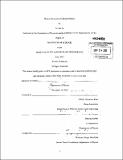Motion-reversal in colloidal walkers
Author(s)
Su, Yi-Han, S.B. Massachusetts Institute of Technology
DownloadFull printable version (2.676Mb)
Other Contributors
Massachusetts Institute of Technology. Department of Physics.
Advisor
Alfredo Alexander-Katz and Mehran Kardar.
Terms of use
Metadata
Show full item recordAbstract
In this research, the manipulation of colloidal systems composed of superparamagnetic particles in water is studied by a simulation method. In response to an external magnetic field, the dipoles drive the beads to self-assemble into chains, which rotate and consequently move across a nearby surface. Under strong surface-interaction, the dynamic and equilibrium structures are modeled using a Bell model and measured using Monte Carlo-type update steps. It is shown that the walking motion can be characterized as two different regimes corresponding to an increase of the rotating arm from half to all of the chain-length as the activation barrier of binding interaction increases with a constant overall increase in energy. When operating at rotational frequencies from 1 Hz to 9 Hz and applied field from I mT to 9 mT, the corresponding translational velocities of chain-like rotors can be approximated with a two-state model until the fragmentation transition of chain-like rotors takes place. The translational velocities of chain-like rotors scale linearly with respect to number of beads.
Description
Thesis (S.B.)--Massachusetts Institute of Technology, Dept. of Physics, 2013. Cataloged from PDF version of thesis. Includes bibliographical references (page 24).
Date issued
2013Department
Massachusetts Institute of Technology. Department of PhysicsPublisher
Massachusetts Institute of Technology
Keywords
Physics.